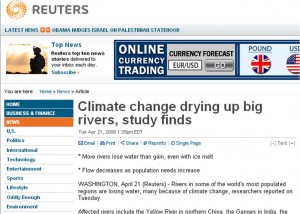“Science” By Press Release
April 21st, 2009Posted by: Roger Pielke, Jr.
A new study on global streamflows has just been announced via press release by NCAR. Here is how the press release opens:
Rivers in some of the world’s most populous regions are losing water, according to a new comprehensive study of global stream flow. The study, led by scientists at the National Center for Atmospheric Research (NCAR), suggests that in many cases the reduced flows are associated with climate change. The process could potentially threaten future supplies of food and water.
Here is what the paper actually says:
We emphasize, however, that the actual streamflow and discharge examined here likely include changes induced by human activities, such as withdrawal of stream water and building dams, and thus they are not readily suitable for quantifying the effects of global warming on streamflow
Lets see how many news stories follow the press release rather than the paper.

April 21st, 2009 at 10:37 am
At the end of the press release, here’s what one author says:
“As climate change inevitably continues in coming decades, we are likely to see greater impacts on many rivers and water resources that society has come to rely on,” says NCAR scientist Kevin Trenberth, a co-author of the study.”
So whatever the data in the paper, we know in which direction the author’s arms are waving. The press release can hardly be accused of distorting the author’s intentions, although it may be distorting the data nonetheless.
April 21st, 2009 at 1:29 pm
Well, this is all very strange. As I understand it, warmer temperatures mean more evaporation into the atmosphere. Because the stuff can’t possibly stay up there forever, it seems to me that it should rain more.
All corrections of incorrectos will be appreciated.
April 21st, 2009 at 2:16 pm
Warmer temps means higher absolute humidity, so more of it can stay up there.
It’s expected to rain more in some places, less in others. The general process by which the atmosphere moves water from one place to another will be amplified by the greater humidity, leaving (on average) wet places wetter and dry places drier. That’s the expectation that I’ve read about. Also, the desert band, which currently centers on 30 degrees (N and S) will shit to a bit higher latitudes. I got this from the recent National Geographic.
Science by press release is a big problem and there are many misinterpretations in all directions. The process by which science gets transmitted to the public and policy-makers has always been problematic when the issue is prominent and affects a lot of people.
April 21st, 2009 at 3:20 pm
So does this mean that the places that are the sources of the rivers, which must now be among the wetter places, will somehow become drier?
April 22nd, 2009 at 9:00 am
While the question about how many stories will follow the press release instead of the paper was rhetorical, you made me look.
This morning, on Google news the score is paper 0, to press release 11. A quote from the first story is:
“According to the NCAR, over two thirds of the 925 rivers that were studied from 1948-2005 have reduced water flow as a direct result of global warming and climate change.”
But I’m not complaining. The press is just as honest about the stories we can’t check as they are about the facts we can verify.
April 22nd, 2009 at 11:56 am
The full article is behind a paywall, but I note that the authors’ abstract of the article does describe conclusions relating to climatic forcing. It states as follows:
“Comparisons with the CLM3 simulation suggest that direct human influence on annual streamflow is likely small compared with climatic forcing during 1948–2004 for most of world’s major rivers. . . . Our results are qualitatively consistent with climate model projections, but contradict an earlier report of increasing continental runoff during the recent decades based on limited records.”
http://ams.allenpress.com/perlserv/?request=get-abstract&doi=10.1175/2008JCLI2592.1
Is the abstract at odds with the actual paper?
April 22nd, 2009 at 1:59 pm
lgcarey
As I understood the abstract, the climatic forcing they are referring to is ENSO not anthropogenic climate change. This does not contradict the excerpts above, which define the human impacts as being related to water use and dam building.
April 22nd, 2009 at 4:32 pm
“So does this mean that the places that are the sources of the rivers, which must now be among the wetter places, will somehow become drier?”
I’m not sure that river headwaters are necessarily “wetter” places. I suppose it might be true if applied to the largest rivers, but for rivers more generally, I don’t think so. Some rivers exist because they have a large catchment area. Obviously they couldn’t be the very driest spot if water gathers.
For example, the headwaters of the Colorado on the west side of Rocky Mountain NP is not a particularly wet place. But the headwaters of the Columbia, in British Columbia, is wet, and is expected to stay so. Most of the larger rivers in the US, in the east, are in wet areas, but many western rivers (Rio Grande, Rogue, Platte, etc) have headwaters in relatively dry areas and could get smaller. Some rivers, like the Arkansas, have headwaters in relatively dry areas, but pass through much wetter areas farther down.
And the wet -> wetter, dry -> drier, is a generalization. There will be exceptions. Connecting this trend, which applies to land regions, to rivers, adds to its complexity since there are many factors that affect rivers. Some rivers may not get smaller overall, but may run higher half the year and lower the other half. This is expected to be the case for the Columbia (which I live right next to).
May 1st, 2009 at 5:47 am
[...] Science is science, right? Not when it’s in a press release. [...]